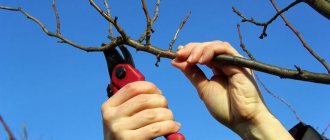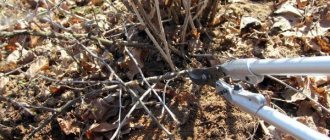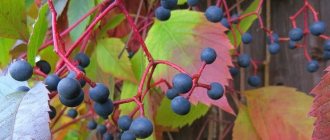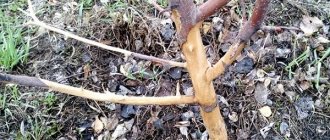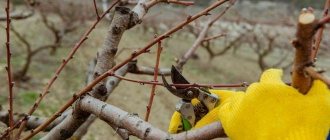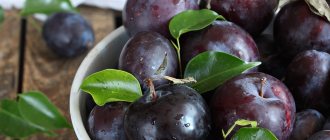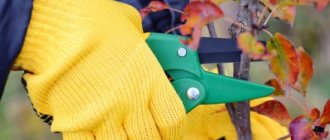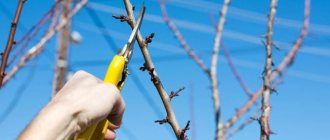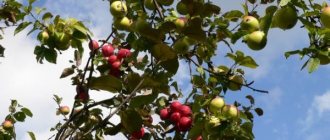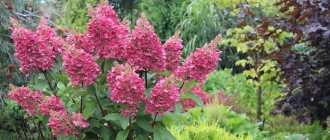As for columnar apple trees, there is a common misconception about their lack of lateral shoot growth.
In this case, there would be no talk of pruning the pyramidal apple tree.
And the question of whether it is necessary to prune a columnar apple tree arises even among experienced gardeners. Let's talk about this further.
The classic “column” is a vertical straight trunk with shortened shoots growing along it, the so-called
ringlets .
The latter are located at an acute angle relative to the central trunk. Attention! An unformed columnar tree similar to a pyramidal poplar. Without proper pruning, it is possible to develop a standard dwarf apple tree with a branched crown.
Formation of columnar apple trees
Whether to prune the garden to form a strict column is an individual choice.
But it is worth considering that the appearance of apple trees is not the only reason for this; in this regard, a number of aspects can be highlighted:
- Formation of the correct shape of the apple tree;
- Prevention of tangling of shoots;
- Strengthening young branches;
- Apple tree rejuvenation;
- Yield growth.
Pruning a columnar apple tree: diagram
Pruning of columnar apple trees is minimal and is mainly aimed at balancing growth and fruiting.
When forming, it is worth taking into account some characteristic features inherent only to low-growing trees.
The central shoot acts as a core for the entire tree and cannot be shortened. As for the lateral ones, there are horizontal and vertical branches.
It is worth dwelling in more detail on how to properly trim side shoots. They are the foundation for the formation of fruiting zones, which subsequently produce a harvest within three to five years. Pruning plays an important role in caring for columnar apple trees.
Pruning includes two main techniques:
- Removal - in the event that only part of the branch is cut off;
- Cutting - the branch is completely removed.
When forming a column, experienced gardeners adhere to the basic rules:
- In the year of planting a young tree, the branches will be pruned into two buds. Thanks to this, the shoots will become stronger and subsequently produce healthier shoots.
- Next year the gardener will have a new job. It is necessary to identify horizontally located branches and trim them. The pruning height is individual, but on average it is about 30 cm. The vertical ones, located closer to the central trunk, are left for further fruiting.
- In the third year of the tree's life, last year's pruning is repeated. The difference is that the shoots that bore fruit in the previous season are additionally removed.
Pruning young columnar apple trees.
Advice! Removing small shoots that are still green and growing from the trunk will not cause harm. On the contrary, such a procedure is necessary. Eliminating excess growth promotes the formation of a powerful central column and abundant fruiting. Further pruning is reduced to leaving branches no older than three to four years old.
If you have any doubts about pruning another branch, you can follow the hint . There should be no branches left on the tree that reach half the thickness of the central conductor.
Proper pruning of columnar apple trees: video advice from Uncle Vanya, a gardener.
Rules for thinning the crown to obtain large fruits
When planting young trees in the garden, it is necessary that the width between the rows does not exceed one and a half meters. This way the branches will grow more actively, the flowering will be abundant and the fruits will ripen faster. New shoots must be regulated, leaving the stem bud located at the very top. In order for growth to continue. The rest must be cut at a thirty-degree angle so that the second bud is at a distance of 3 centimeters from the trunk. After 12 months, strong, young shoots will appear here.
During the next spring pruning, the shoot that has grown next to the horizontal branch remains. The one that is located vertically is trimmed in the same way as last year. Flowers will begin to form on a short branch positioned horizontally. And the one that is vertical will have new shoots, 2 of them.
One stronger one is left, and the other is cut off. Over the next 5 years, the pruning principle will remain the same. The cut area needs to be lubricated. Garden pitch, clay or oil paint are suitable for this.
It is important to know that pruning the top occurs only if the upper shoot freezes, from which other shoots begin to appear.
The formation of the crown can also take place in another way, but this method is considered the most difficult. It involves both pruning and pinching. In this way, you can turn ordinary apple tree varieties into a columnar apple tree. Or, on the contrary, you can plant a columnar apple tree and deeply immerse the dwarf rootstock into it. In this case, roots will appear at the top, and the apple tree will grow to its usual size.
A seedling is a rootstock with a scion that takes root in the nursery. Related to this is the need to prune a young plant during its first life after planting, when it has not yet had time to take root. Further trimming is carried out according to the scheme that was described earlier.
When to prune a columnar apple tree
The timing of pruning is individual for each variety and is determined by the characteristics of the variety. Formation can be carried out in four stages:
- Winter pruning is considered the main one . The most successful period for its implementation is pre-spring.
- Spring pruning is the right time to identify the central shoot. Produced after flowering.
- Summer pruning is designed to remove unnecessary young shoots.
- Strong vertical shoots are removed during autumn pruning . At the same time, you can thin out thickened areas.
This is an annual plan for the formation of columnar apple trees . But each of the points should be given special attention.
Possible mistakes
The growth and development of the garden crop will depend on how well the gardener carries out the pruning. The most common mistakes made during this process are:
- branches are cut using blunt equipment, as a result, rags are formed at the cut site, and the planting is injured;
- the presence of long stumps causes the death of the entire shoot, it simply dries out and dies;
- the cuts are made too close to the bud, which reduces the rate of its formation.
Compliance with the pruning pattern and timing will help to avoid many unpleasant moments when growing pyramidal apple trees. Regular procedure will give the tree a beautiful and regular crown, increase the yield and quality of the fruit.
Winter pruning of a columnar apple tree
The columnar apple tree has no permanent branches.
Due to their strictly cylindrical shape, the branches of the lower part of the tree are in slightly worse conditions .
Sunlight does not hit them as much as the top ones.
During the period of winter pruning, fruiting zones are formed, gradually shifting to the upper tiers.
Broken and dry branches are also .
To reduce the load of future fruits on the tree, shoots that are too weak are removed.
Botanical characteristics
Columnar trees, unlike their larger counterparts, are smaller in size and easier to care for. The height of an adult plant, the characteristics of which depend on the type of supply used, is 4 m. The columnar variety is grown in areas with a mild and warm climate. A sharp cold snap has a negative impact on the condition of green space. The average yield from 1 plant, depending on care, reaches 2.5-4 kg. Other botanical characteristics:
- large and medium fruits;
- juicy sweet pulp;
- the presence of a superficial root pattern makes the tree vulnerable to the vagaries of nature;
- apical buds are more demanding of heat.
May be interesting Description of the Zhigulevskoe apple tree (Photos, reviews) Pruning an apple tree in the fall for beginners in pictures step by step How and with what to feed an apple tree in the fall Correct and timely pruning in autumn or spring improves the quality of the fruit. The fewer extra shoots, the more actively the plant directs incoming nutrients to the formation of buds and fruits. There are other factors that may require pruning:
- the shape of the crown is broken;
- the thickening of the crown makes it vulnerable to pests;
- rapid increase in green mass;
- small fruits are formed.
The problem develops gradually, so even a beginner has enough time to make a decision. Just look at the photo below to see the listed reasons for carrying out the mentioned manipulation.
On a note!
The purpose of spring or autumn pruning is to remove excess growth points and form the crown and trunk.
Pruning columnar apple trees in spring: diagram
The main task is to finish pruning before the sap begins to flow.
The essence of the formation is that after pruning, growth increases several times . From the four to five buds remaining on the pruned branch, gardeners receive the same number of new shoots.
This type of pruning is called pinching or pinching . New growth is not the only goal of the procedure.
Learn everything from how to prune columnar apple trees in the spring: the video will clearly show the intricacies of the process:
After the winter cold, the frozen tips of the branches are removed. This procedure promotes rejuvenation and healing of the apple tree.
Pruning columnar apple trees in summer: diagram
In summer, unnecessary green shoots of the current year are removed. They are easy to identify: as a rule, they grow directly from the central conductor . You don't need pruning shears to remove them. Summer pruning of columnar apple trees is done by plucking.
A properly pruned columnar apple tree.
Carefully! Removing small shoots will not harm the apple tree, but requires great care. It is important not to damage the bark. It is much easier for a tree to endure a couple of large wounds than many small ones.
Pruning columnar apple trees in autumn
In the autumn period after harvesting, when the movement of sap stops, sanitary pruning of trees is carried out. Columnar apple trees in the fall also require this method of care.
All unnecessary branches are deleted:
- Dry;
- Broken;
- Bough;
- Crossed over each other.
Without such ballast, it will be easier for the tree to survive the winter. Special attention is paid to branches that are dried out and spoiled by pests.
Proper pruning of a columnar apple tree in the fall: video for beginners from an agricultural school
Watch how to prune a columnar apple tree in the fall - the video will help you figure it out:
You may also find this video useful about preparing mash to putty on an apple tree after pruning:
Don’t forget about the current year’s growth growing from the central shoot. Removing them in the summer does not ensure their absence by autumn.
Listed above are general recommendations for caring for columnar apple trees regarding pruning and shaping .
But for each variety the specifics of care are individual. And then pruning and shaping of the columnar apple tree is carried out according to the situation.
The age of the tree also requires its own adjustments. Pruning of young trees is most important .
Experts recommend starting the formation of lateral branches in the first year. Developing annual shoots are pinched into two buds. In this case, it is recommended to leave a pair of lower buds at the base of the branch. Next year, strong young shoots will be formed from them.
Some tips
Proper care and pruning are the key to a stable harvest of columnar crops. Therefore, in order to enjoy a good harvest of bulk apples every year, take note of a few tips:
- The top of dwarf trees is considered the most vulnerable place; for this reason, try to protect the crown bud, especially from severe frosts.
- Try to identify the 2 strongest sprouts, which are left for further development. And it is advisable to excise all the rest.
- By leaving a long stump after pruning, you contribute to its death in the future.
- Excessively shortened stumps will become an obstacle for the tree, which will not be able to form buds in this area.
- Pay attention to the cuts; they should not be skewed, otherwise the crop will be injured.
Important! When pruning, try to keep 3 buds on each pagon. Those gardeners who follow this rule form good and strong branches.
And one more piece of advice from experienced summer residents, when starting pruning, stock up on sharp tools that have been previously disinfected. This way you will minimize all risks of damage to the tree. At the same time, do not forget, after the manipulation, to cover all the excised areas with varnish or clay mash.
